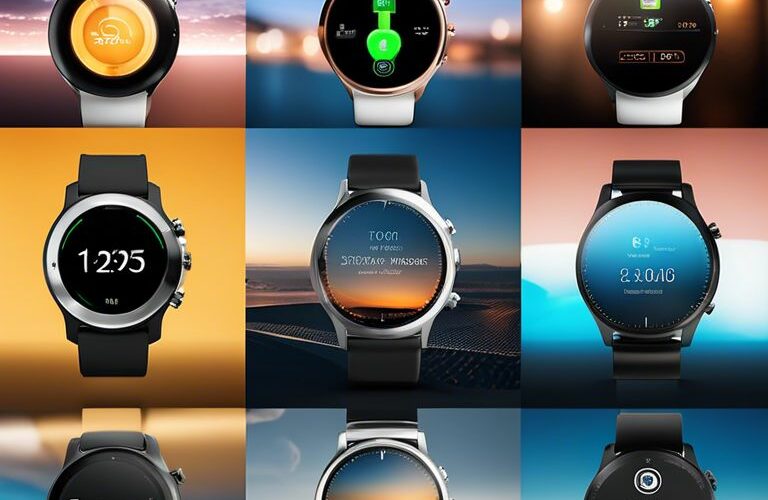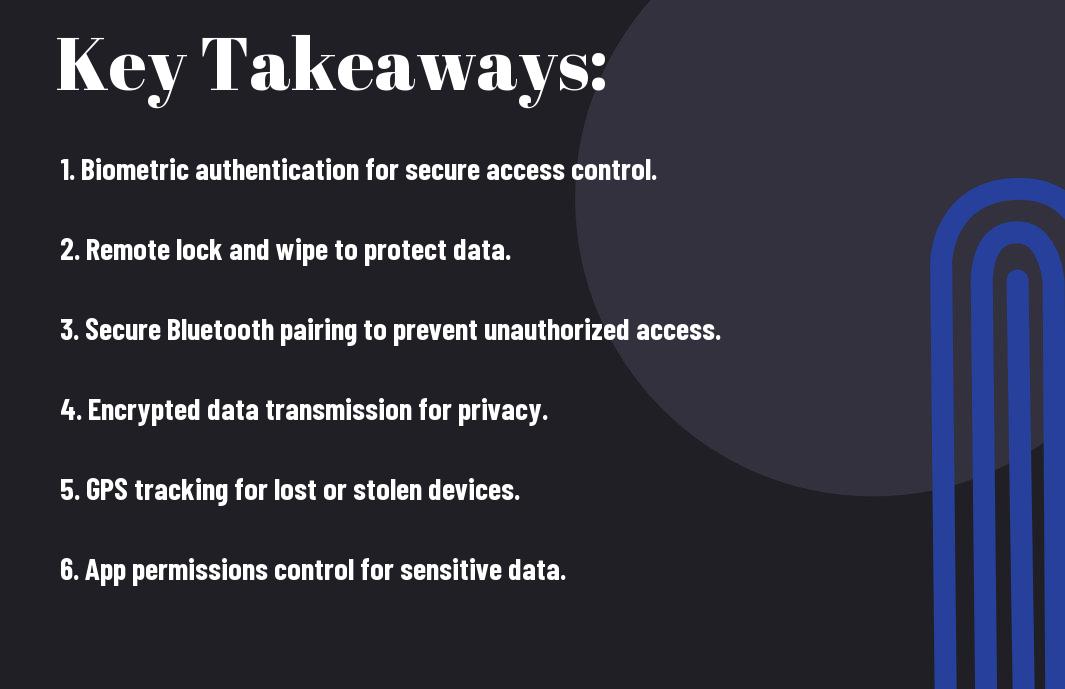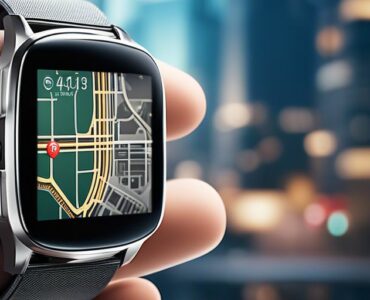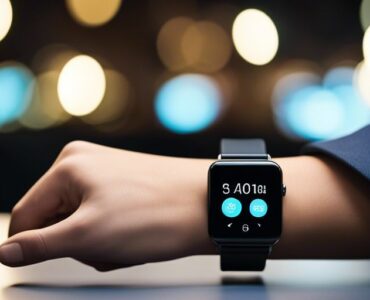Ensuring the security of your smartwatch is crucial in protecting your personal and sensitive information. As the use of smartwatches continues to grow, it’s important to understand the security features that these devices offer to keep your data safe. In this blog post, we will explore the various security measures that smartwatches have in place to protect you from potential threats.
Table of Contents
Key Takeaways:
- Encryption: Smartwatches typically use strong encryption methods to protect data transmitted between the device and the smartphone, ensuring that sensitive information remains secure.
- Biometric Security: Many smartwatches offer biometric authentication features such as fingerprint scanning or heart rate monitoring to ensure that only authorized users can access the device and its data.
- Remote Wipe and Lock: In the event of loss or theft, smartwatches often have the capability to remotely wipe or lock the device to prevent unauthorized access to personal information.
Core Security Features of Smartwatches
Clearly, the security of your smartwatch is of utmost importance to protect your personal data and sensitive information. Smartwatches come equipped with various security features to ensure the safety of your data. Let’s explore some of the core security features of smartwatches.
Encryption Mechanisms
Smartwatches utilize encryption mechanisms to protect your data from unauthorized access. When you store sensitive information such as health data, payment information, or personal messages on your smartwatch, it is encrypted to prevent it from being intercepted or accessed by malicious entities. Encryption ensures that even if your smartwatch is lost or stolen, your data remains secure.
Authentication and Access Control
Authentication and access control measures are crucial in safeguarding your smartwatch. These features include passcodes, patterns, biometric authentication (such as fingerprint or heart rate recognition), and proximity-based authentication. These mechanisms ensure that only authorized users have access to the data stored on the smartwatch. By enabling strong authentication and access control, you can prevent unauthorized individuals from tampering with or accessing your personal information.
Enhancing Smartwatch Security Through Design and Operation
After considering the security features of smartwatches, it is important to discuss how these devices can be further secured through design and operation. This involves a focus on firmware update procedures and effectiveness, as well as resistance factors against unauthorized access.
Firmware Update Procedures and Effectiveness
When it comes to enhancing the security of your smartwatch, ensuring that the firmware is regularly updated is crucial. Firmware updates often include security patches and fixes for vulnerabilities that have been identified since the release of the device. It is important that you stay informed about the release of these updates and promptly apply them to your smartwatch to ensure that it remains secure.
Resistance Factors Against Unauthorized Access
There are several resistance factors that can be implemented to protect your smartwatch against unauthorized access. These include biometric authentication such as fingerprint recognition or iris scanning, strong password requirements, and two-factor authentication methods. Additionally, some smartwatches are equipped with remote lock and wipe features, allowing you to remotely lock or erase the data on your device in the event of loss or theft. This multi-layered approach to security significantly reduces the risk of unauthorized access to your smartwatch and the sensitive information it may contain. This comprehensive defense not only adds an extra layer of security but also provides peace of mind in knowing that your smartwatch and data are well protected.
Integration and Compatibility Concerns
To ensure the security of your smartwatch, it is important to consider its integration and compatibility with other devices. The interconnectivity of your smartwatch with your smartphone, computer, and other smart devices can pose potential security risks if not properly managed. In this chapter, we will discuss the interoperability with various devices and the customization and adjustability for enhanced protection.
Interoperability with Various Devices
When using a smartwatch, it is crucial to ensure that it is compatible with your smartphone, computer, and any other devices that you may connect it to. Compatibility issues can lead to security vulnerabilities, as they can create loopholes for unauthorized access to your personal data. Make sure that your smartwatch and its accompanying apps are designed to work seamlessly with your other devices, and always keep them updated to patch any potential security issues.
Customization and Adjustability for Enhanced Protection
One of the security features to look for in a smartwatch is its customization and adjustability options. The ability to set up secure authentication methods, such as PIN codes, fingerprint recognition, or even biometric sensors, can enhance the protection of your device and the sensitive data it holds. Additionally, the option to customize privacy settings and control the access permissions of various apps can help you better manage the security of your smartwatch.
By understanding the interoperability with various devices and the customization and adjustability options for enhanced protection, you can take proactive measures to ensure the security of your smartwatch. Remember to always stay informed about the latest security updates and best practices for using your smartwatch securely. Your diligence in managing the integration and compatibility concerns of your smartwatch will help you safeguard your personal data and privacy. Be proactive in updating your devices and use secure authentication methods to prevent unauthorized access to your smartwatch.
Advanced Security Options and Considerations
Despite the convenience and cool features of smartwatches, it is important to consider their security options and take the necessary precautions to protect your personal data. Here are some advanced security features and considerations to keep in mind:
- Encryption:
What: Your smartwatch should have end-to-end encryption to protect your data from unauthorized access. Why: Encrypting your data ensures that even if someone manages to intercept it, they won’t be able to make sense of it without the encryption key. - Remote Wipe:
What: This feature allows you to remotely erase all data on your smartwatch in case it is lost or stolen. Why: By using remote wipe, you can prevent unauthorized access to your personal information.
Deployment of Multi-factor Authentication
When it comes to securing your smartwatch, multi-factor authentication (MFA) is an important tool. With MFA, you can add an extra layer of security by requiring two or more forms of verification before granting access to your device. This could include a combination of something you know (password), something you have (smartphone or token), and something you are (biometric data). By deploying MFA, you significantly reduce the risk of unauthorized access to your smartwatch and the sensitive data it holds.
The Role of Bandwidth and Cache in Security
Bandwidth and cache play a crucial role in the security of your smartwatch. Bandwidth determines the speed at which data is transmitted and received, while cache temporarily stores data to reduce loading times. However, an abundance of cache can also pose a security risk as it can be accessed by unauthorized parties. Therefore, it is important to manage your smartwatch’s bandwidth and cache settings to ensure optimal security. You should also regularly clear your cache to prevent any potential security breaches.
Conclusion
Hence, it is important to be aware of the various security features of smartwatches to ensure that your personal data and information are protected. By understanding the capabilities of encryption, biometric authentication, and remote lock and wipe features, you can take proactive steps to safeguard your smartwatch and the data it contains. Additionally, it is essential to keep your smartwatch’s software and security measures up to date to mitigate any potential risks. By staying informed and utilizing the available security features, you can confidently enjoy the convenience and functionality of your smartwatch while keeping your personal information secure.
FAQ
Q: What security features do smartwatches have?
A: Smartwatches come with various security features such as biometric authentication, which includes fingerprint sensors and heart rate monitors for user identification. They also have encryption capabilities to protect data and secure operating systems to prevent unauthorized access.
Q: How do smartwatches protect user data?
A: Smartwatches use data encryption techniques to protect user data. They also have secure Bluetooth connections and advanced authentication methods to ensure that only authorized users can access sensitive information stored on the device. Additionally, smartwatches have remote locking and wiping features to safeguard data in case of theft or loss.
Q: Can smartwatches be hacked?
A: While smartwatches have robust security features, like any electronic device, they are not completely immune to hacking. However, manufacturers constantly release software updates and security patches to mitigate potential vulnerabilities. Users can further enhance security by setting strong passwords and enabling two-factor authentication on their smartwatches.












Add comment